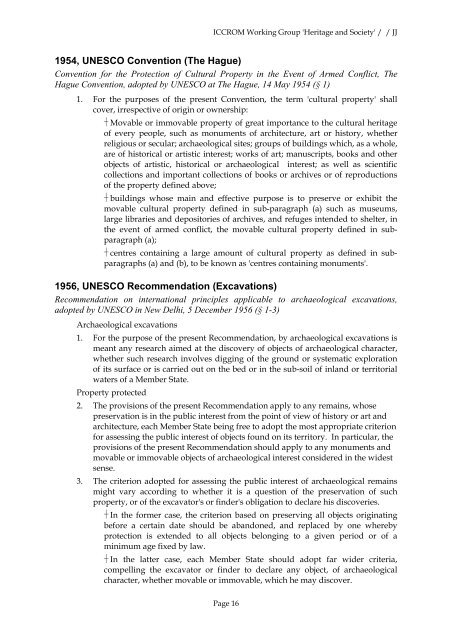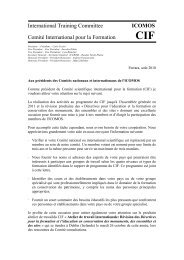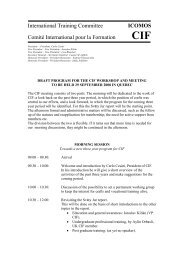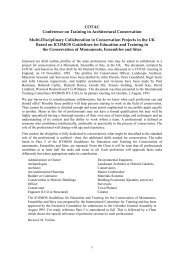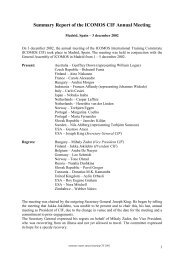Definition of Cultural Heritage -- References to ... - CIF - Icomos
Definition of Cultural Heritage -- References to ... - CIF - Icomos
Definition of Cultural Heritage -- References to ... - CIF - Icomos
You also want an ePaper? Increase the reach of your titles
YUMPU automatically turns print PDFs into web optimized ePapers that Google loves.
ICCROM Working Group '<strong>Heritage</strong> and Society' / / JJ<br />
1954, UNESCO Convention (The Hague)<br />
Convention for the Protection <strong>of</strong> <strong>Cultural</strong> Property in the Event <strong>of</strong> Armed Conflict, The<br />
Hague Convention, adopted by UNESCO at The Hague, 14 May 1954 (§ 1)<br />
1. For the purposes <strong>of</strong> the present Convention, the term 'cultural property' shall<br />
cover, irrespective <strong>of</strong> origin or ownership:<br />
Movable or immovable property <strong>of</strong> great importance <strong>to</strong> the cultural heritage<br />
<strong>of</strong> every people, such as monuments <strong>of</strong> architecture, art or his<strong>to</strong>ry, whether<br />
religious or secular; archaeological sites; groups <strong>of</strong> buildings which, as a whole,<br />
are <strong>of</strong> his<strong>to</strong>rical or artistic interest; works <strong>of</strong> art; manuscripts, books and other<br />
objects <strong>of</strong> artistic, his<strong>to</strong>rical or archaeological interest; as well as scientific<br />
collections and important collections <strong>of</strong> books or archives or <strong>of</strong> reproductions<br />
<strong>of</strong> the property defined above;<br />
buildings whose main and effective purpose is <strong>to</strong> preserve or exhibit the<br />
movable cultural property defined in sub-paragraph (a) such as museums,<br />
large libraries and deposi<strong>to</strong>ries <strong>of</strong> archives, and refuges intended <strong>to</strong> shelter, in<br />
the event <strong>of</strong> armed conflict, the movable cultural property defined in subparagraph<br />
(a);<br />
centres containing a large amount <strong>of</strong> cultural property as defined in subparagraphs<br />
(a) and (b), <strong>to</strong> be known as 'centres containing monuments'.<br />
1956, UNESCO Recommendation (Excavations)<br />
Recommendation on international principles applicable <strong>to</strong> archaeological excavations,<br />
adopted by UNESCO in New Delhi, 5 December 1956 (§ 1-3)<br />
Archaeological excavations<br />
1. For the purpose <strong>of</strong> the present Recommendation, by archaeological excavations is<br />
meant any research aimed at the discovery <strong>of</strong> objects <strong>of</strong> archaeological character,<br />
whether such research involves digging <strong>of</strong> the ground or systematic exploration<br />
<strong>of</strong> its surface or is carried out on the bed or in the sub-soil <strong>of</strong> inland or terri<strong>to</strong>rial<br />
waters <strong>of</strong> a Member State.<br />
Property protected<br />
2. The provisions <strong>of</strong> the present Recommendation apply <strong>to</strong> any remains, whose<br />
preservation is in the public interest from the point <strong>of</strong> view <strong>of</strong> his<strong>to</strong>ry or art and<br />
architecture, each Member State being free <strong>to</strong> adopt the most appropriate criterion<br />
for assessing the public interest <strong>of</strong> objects found on its terri<strong>to</strong>ry. In particular, the<br />
provisions <strong>of</strong> the present Recommendation should apply <strong>to</strong> any monuments and<br />
movable or immovable objects <strong>of</strong> archaeological interest considered in the widest<br />
sense.<br />
3. The criterion adopted for assessing the public interest <strong>of</strong> archaeological remains<br />
might vary according <strong>to</strong> whether it is a question <strong>of</strong> the preservation <strong>of</strong> such<br />
property, or <strong>of</strong> the excava<strong>to</strong>r's or finder's obligation <strong>to</strong> declare his discoveries.<br />
In the former case, the criterion based on preserving all objects originating<br />
before a certain date should be abandoned, and replaced by one whereby<br />
protection is extended <strong>to</strong> all objects belonging <strong>to</strong> a given period or <strong>of</strong> a<br />
minimum age fixed by law.<br />
In the latter case, each Member State should adopt far wider criteria,<br />
compelling the excava<strong>to</strong>r or finder <strong>to</strong> declare any object, <strong>of</strong> archaeological<br />
character, whether movable or immovable, which he may discover.<br />
Page 16


